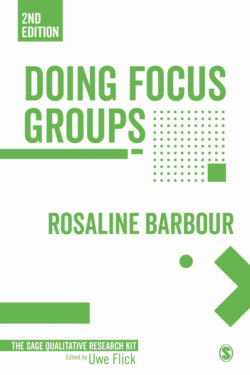Doing Focus Groups

Реклама. ООО «ЛитРес», ИНН: 7719571260.
Оглавление
Rosaline Barbour. Doing Focus Groups
Doing Focus Groups
Contents
List of illustrations. Boxes
Editorial introduction
Introduction to The SAGE Qualitative Research Kit
What is qualitative research?
How do we conduct qualitative research?
scope of The SAGE Qualitative Research Kit
About this book and its second edition
Acknowledgements
Chapter One Introducing focus groups. Contents
Objectives
Outline of the book
Antecedents and their lasting influence
Key points
Chapter Two Focus groups in practice. Contents
Objectives
Assets of focus groups. Accessing the ‘hard-to-reach’
Engaging with the ‘vulnerable’
Broaching difficult or ‘sensitive’ topics
Limitations of focus groups
Accessing ‘attitudes’
Researchers’ or participants’ concerns?
Claims and challenges in focus
Key points
Chapter Three Focus groups in context. Contents
Objectives
Locating focus groups – philosophical and methodological traditions
Which qualitative tradition?
Disciplinary adoptions and adaptions
Key points
Chapter Four Research design. Contents
Objectives
Mixed methods designs
Deciding whether to use one-to-one interviews or focus groups
One-off or repeat focus groups?
Teleconferencing and video-conferencing
Online focus groups
Mixing qualitative methods
Triangulation
Research design practicalities
Settings
Matching moderator and group
Transcription
Conversation analysis
Key points
Chapter Five Sampling. Contents
Objectives
Identifying sampling possibilities
Principles of qualitative sampling
Group composition
Number and size of groups
Pre-existing groups
Making the most of the potential for comparison
Further analytic potential
Returning to the field and second-stage sampling
Key points
Chapter Six Generating data. Contents
Objectives
Developing and using topic guides
Stimulus materials and exercises
Visual materials
Moderators’ skills
Seeking clarification
Maintaining focus/steering discussion
Picking up on cues
Using focus groups to develop stimulus materials
Probe Set 1
Probe Set 5
Thinking comparatively and anticipating analysis
Key points
Chapter Seven Ethics and engagement. Contents
Objectives
Impact of focus group participation
Debriefing
Special considerations and challenges. Vulnerable groups
Generating data in an ethical and appropriate way
Cross-cultural research
Key points
Chapter Eight Making sense of focus group data. Contents
Objectives
Generating a provisional coding frame
Grounded theory
Project on post-partum weight loss. Engagement with interventions
Appropriateness/interpretation of information
Modelling and refining coding frameworks
Constant comparison: inter- and intra-group differences
Similarities between groups: interrogating surprises
Personal and professional backgrounds as resources
Key points
Chapter Nine Getting the most out of focus groups. Contents
Objectives
Utilizing interaction and group dynamics to analytic advantage
Focus group participants as ‘co-analysts’
Embracing complexity
Engaging with theory
Hybrid or composite approaches
Presenting and utilizing findings from focus group studies
1) Police knowledge about ‘micro places of vulnerability’ is nuanced and untapped
2) The cycle of crisis response is perpetual
3) There are few ‘sticks’ and fewer ‘carrots’ to influence behaviour
4) Procedural justice is critical to engagement and recovery
5) System-wide information sharing is essential
Transferability of focus group findings
Concluding remarks
Key points
Glossary
References
Index
Отрывок из книги
For Mike and Alasdair
In recent years, qualitative research has enjoyed a period of unprecedented growth and diversification as it has become an established and respected research approach across a variety of disciplines and contexts. An increasing number of students, teachers and practitioners are facing questions and problems of how to do qualitative research – in general and for their specific individual purposes. To answer these questions, and to address such practical problems on a how-to-do level, is the main purpose of The SAGE Qualitative Research Kit.
.....
Again drawing on the community development approach and, here, echoing its concern with addressing power differentials between researcher and participants, focus groups have frequently been employed in action-oriented projects, seeking to work with patients, clients, or community members in order to inform or, even to change, professional practice or policy. Examples include the work of Makosky-Daley et al. (2010) who explored, with American-Indians in Kansas and Missouri, the barriers to breast and colorectal cancer screening and use of the Internet for obtaining health-related information. Another example is afforded by Littlechild et al. (2015) who engaged with older people (including black and minority ethnic community members and people with dementia) in order to evaluate the impact of health services and policy. (These projects are further discussed in the next chapter, in relation to the specific advantages afforded by focus groups.)
Some researchers have also employed focus groups to good effect in communicating with or, even, working collaboratively with policy makers. Examples include the work of Wutich et al. (2010) who elicited the views of water policy makers in Arizona. In the context of research into sustainability and everyday practice of members of the general public, Prades et al. (2013) also sought to engage policy makers through an action research approach.
.....